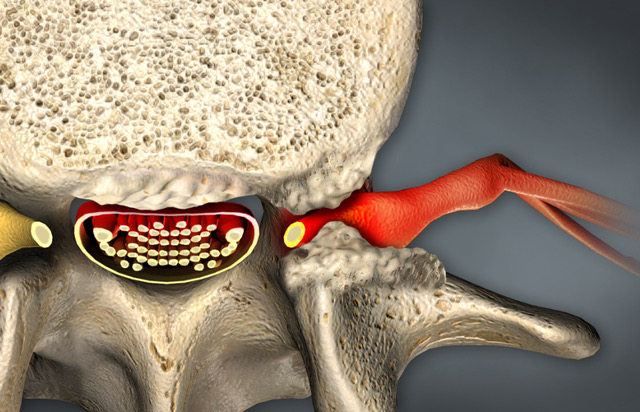Foraminal Narrowing
Foraminal narrowing occurs when the foramina or canals through which the nerves exit the spine become narrowed. It may occur due to arthritis, bone spurs, spondylolistesis, herniated discs or other conditions. As these canals become narrowed, they pinch the nerves that goes thru it causing pain, weakness, numbness or tingling along the nerve pathway. This is referred to as neural foraminal narrowing and it can cause radiating pain along the length of the nerve as well as numbness, tinging, or weakness within the muscle group innervated by the affected nerve.

Overview
At one time or another, back pain affects about 80% of the U.S. population. The degree and duration vary greatly. Foraminal narrowing can be a source of chronic or acute back pain.
Anatomy
The spinal column is a strong, yet flexible structure that surrounds and protects your spinal cord. It is made up of 34 bones: 24 articulated vertebrae and 10 naturally fused vertebra that make up the sacrum and coccyx.
Each vertebra has a vertebral arch and a large, cylinder-shaped body. The arch is made up of the spinous process and a facet joint on each side. Muscles, ligaments, cartilage, and discs are attached to various parts of the vertebra.
The space between the arch and the vertebral body is the spinal canal. The spinal canal houses your spinal cord. There are other openings on the stacked vertebrae called the foramina (singular foramen), where the nerve roots branch out of the spinal cord. At every level of the spine, a pair of spinal nerves exits the spinal column through the foramina.
What Is Foraminal Narrowing
Neural foraminal narrowing, a type of spinal stenosis, a spinal condition that can cause acute or chronic pain when the openings through which the spinal nerves exit the spine become narrowed and impinge on the nerves.
Causes
While some causes of foraminal narrowing are due to genetics, the most common cause is the natural aging of the spine. The foraminal canal can narrow due to degenerative spine conditions that develop with the weakening and deterioration of the spine.
Conditions Causing a Narrowing of the Foramina
Degenerative disc disease refers to the gradual degeneration of the discs that occurs over time as the spine ages. As the discs degenerate, the foramina may narrow and compress the nerve roots. The symptoms may vary, and some people who have disc degeneration do not have symptoms. Below are some of the conditions that can cause a narrowing of the foramina:
- Herniated disc
- Bulging disc
- Bone spurs
- Spondylolisthesis
- Spinal arthritis
- Trauma and injury
Symptoms
In many cases, the symptoms of foraminal narrowing begin gradually and are sometimes mistaken for muscle soreness. However, they almost always worsen over time unless properly treated. The most common foraminal narrowing symptoms include:
- Acute or chronic neck or back pain
- Muscle weakness
- Numbness or tingling in the extremities
- The feeling of pins and needles or extreme heat
- Traveling pain along the nerve’s path (Radiculopathy)
There are rare cases where spinal degeneration and nerve compression require emergency treatment. Patients who are experiencing bladder or bowel movement incontinence, extreme muscle weakness in the legs, or excessive pain should visit the emergency room immediately. These could be symptoms of a serious spinal problem including cauda equina syndrome, a serious disorder that needs urgent medical attention.
Diagnosing Neural Foraminal Narrowing
To diagnose foraminal narrowing, your doctor will review your medical history and discuss the exact nature of your symptoms. Your doctor or spine surgeon will look for levels of pain, limitations of movement, loss of reflexes, and other symptoms. In addition, they may order imaging studies tests such as x-rays, CT scans, and MRI to rule out tumors, injuries, or abnormalities, assess the damage to soft tissues, and see the size, shape, and nearby structures in the spinal canal.
Treatment for Foraminal Narrowing
Pain caused by foraminal narrowing is first treated by conservative methods. However, if conservative treatment fails to alleviate the symptoms then surgical treatment may be necessary. Foraminal narrowing treatment is designed to reduce inflammation and provide pain relief as well as strengthen the muscles that support the spine.
Non-Surgical Treatment
Non-surgical treatment options may include:
- Over-the-counter non-steroidal anti-inflammatory drugs (NSAIDs)
- Prescription pain medication
- Exercise
- Physical therapy
- Hot/cold therapy
- Changes in Behavior
Surgical Treatment
If conservative, non-surgical treatment methods provide little or no pain relief after a few months, your doctor may recommend a surgical intervention. Surgical procedures may include:
- Foraminotomy – to create more space in the foramina
- Laminectomy/Laminotomy – to create space for the spinal cord and nerves
- Facetectomy – to relieve spinal pressure
- Discectomy – to remove a diseased portion of a disc causing nerve compression
- Facet Thermal Ablation – to vaporize irritated and painful nerves around the facet of the vertebrae
Your spine surgeon will consult with you about which procedures are appropriate for your condition.
Prevention & Self-Care
Foraminal narrowing is a condition that often develops with age. While you may not be able to prevent its development completely, there are some steps you can take to slow it down and keep your spine as healthy as possible.
- Don’t smoke and drink little alcohol
- Consume plenty of food low in saturated fat and high in omega-3 fatty acids and calcium
- Drink plenty of water
- Exercise
- Regular, gentle stretching
- Avoid pulling or lifting heavy objects
- Lose weight – obesity can put a lot of pressure on your spine
See our youtube channel to see our patients’ recovery stories by clicking here.
